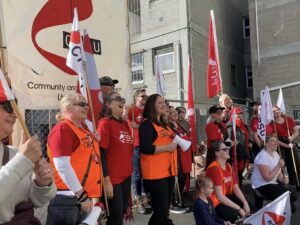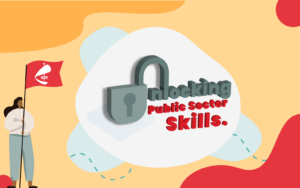
Know Your Rights at Work
Your Employer has an obligation under Work Health and Safety law to eliminate, or if not reasonably practicable to do so, at least minimise the risks of COVID in the workplace – so far as is reasonably practicable. Your Employer also has an obligation to consult with workers and their health and safety representatives regarding COVID-19 risks and how these risks are to be managed (such as a COVID-19 Safety Plan).
What qualifies as ‘reasonably practicable’ can differ from workplace to workplace. For some it could be as straightforward as opening windows or spreading out work to maximise physical distancing. In some cases, this is easier said than done. In 2022, the CPSU successfully pushed for an audit of every window in Tasmanian public sector schools, revealing over 8,000 which required maintenance before they could be opened to allow for adequate ventilation. It’s an example of how useful your union can be in addressing concerns workers you or your colleagues have tried to get addressed individually, without success.
Ways to improve air quality:
• Opening windows wherever it is possible – including in vehicles.
• Ensuring that the air conditioning systems are well maintained and circulating fresh air – not recirculating air.
• Increasing the air exchange rate, which is the measure of the number of times the air inside a building gets replaced with air from outside in an hour. The actual air exchange rate required will depend upon the number of people and size of the area.
• Requesting that your employer provide portable air filters or air purification systems.
Portable CO2 monitors can be used that check the levels of CO2 in your workspace, which may help to indicate how likely you are to be exposed to lingering aerosols carrying risk of infection. As a rule of thumb, the outside air we breathe is about 300-500 ppm of CO2. Indoor C02 levels need to be kept lower than 1000ppm to be safe. If your workplace doesn’t have access to a portable CO2 monitor and you have concerns, we’re here to help! Contact the CPSU at cpsu@tas.cpsu.com.au to arrange a visit from a CPSU Organiser!
It’s also important to ensure physical distancing in the workplace and adhering to density limits (e.g., occupancy limits for a meeting room or lift). Ways of improving physical distancing at work can include exercising options around working from home, or relocating work tasks to different areas of the workplace or off-site if possible.
Respiratory protection, like other PPE, is the lowest level of control. PPE should be used in addition to addressing ventilation, not instead of it. Wearing masks including improved masks such as P2 or N95 have been shown to reduce the risk of transmission. If your employer’s COVID-19 Safety Plan mandates mask use in certain settings, they must be provided by your employer and they cannot charge you for it or deduct it from your wages.
• A guide from Australian experts at OzSAGE on how to keep Indoor Air Safer: https://ozsage.org/wp-content/uploads/2021/09/Safe-Indoor-Air-advice.pdf
• Australian Health Protection Principal Committee (AHPPC) statement on the role of ventilation in reducing the risk of COVID-19: https://www.health.gov.au/news/australian-health-protection-principal-committee-ahppc-statement-on-the-role-of-ventilation-in-reducing-the-risk-of-transmission-of-covid-19
How can I get help to raise an issue?
Unions are able to assist workers to exercise their rights to implement effective protections, this can include providing advice about health and safety or assisting worker elected health and safety representatives to issue legally enforceable directions (PINs) to implement a particular safety measure.
What if my workplace doesn’t have an HSR?
Health & Safety Representatives have unique powers under the WHS Act to ensure Employers are accountable to their obligations to workers. All workers have the legal right to request, at any time, that their Employer negotiate with workers to determine work groups eligible to nominate and elect an HSR. For larger workplaces, such as those spread across multiple floors or with teams in different parts of the state, this could mean multiple HSRs.
• Read about how Child Safety workers turned to their HSR to address unsafe conditions: https://www.cpsu.com.au/child-safety-workers-took-action-at-st-johns-park-and-won/
• Read this article on a CPSU School Business Manager’s experience becoming an HSR: https://www.cpsu.com.au/becoming-an-hsr-changed-everything/
Note on Getting Tested
As always, you have a right not to go to work if you are sick. For COVID-19 testing, RAT tests are still readily available in pharmacies. PCR testing, while more accurate (especially for some strains), is no longer available through drive-in testing clinics. However you can still contact your GP to arrange a self-collection testing kit.
For more information on GP referred self-collection speak to your health provider. If you cannot access a GP or are at higher risk of severe illness, call the COVID@homeplus care team on 1800 973 363 for assistance. They may help you to access a self-collection kit via referral to a pathology service.
Get More Information on Testing: https://www.health.tas.gov.au/health-topics/coronavirus-covid-19/testing








